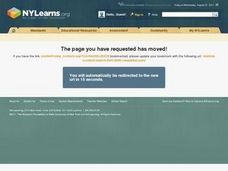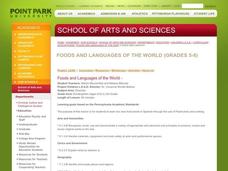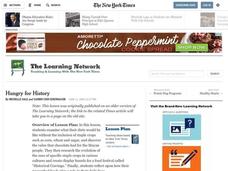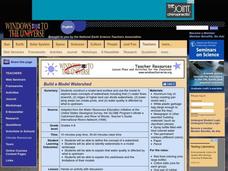Curated OER
ADULT ESOL LESSON PLAN--Communicate Effectively on Health and Nutrition Topics
Students, while reviewing an extensive vocabulary list on the board, identify basic food groups with the help of picture cards. As a group, they create a collage of healthy and unhealthy foods using pictures from magazines and newspapers.
Curated OER
Three Healthful Meals: A Practical Food-Guide-Pyramid Activity
Students activate their knowledge of the food guide pyramid and the basic food groups in order to plan nutritious meals. They collect a handful of food images from magazines and glue them to the appropriate plates.
Curated OER
Nutrition Unit
First graders complete activities for the six basic food groups. For this food groups lesson, 1st graders view examples of food samples from the various groups and sample the foods. Students discuss the food pyramid and draw a fruit or...
Curated OER
Food Group Fun
Students explore the four food groups and nutrition. They cut out pictures of food from newspapers and magazines, create placemats, and create an ABC book of food.
Curated OER
What's on My Plate?
Kids work together in groups to discuss and understand the differences between a typical diet and a healthy one. They use the My Plate recommendations to compare what they eat with what they should be eating according to the MyPlate...
Curated OER
Food Fat
Students evaluate snack foods based on calories and fat. In small groups, they use this information to make informed and wise food choices. Students graphically represent the fat in a food by measuring the equivalent of the food fat with...
Curated OER
Fun with Food
Students explore the Spanish equivalents for everyday food items and determine reasonable prices for those items using the currency of Spanish speaking countries.
Curated OER
Food Chains
Students study food chains by creating their own slide show using KidPix. They compare information after sharing their slide shows as a whole group. As the children are watching the slide shows of their peers, they tally every time...
Curated OER
Nutrition
Learners create a video incorporating clay animation and skits. Using their video creation, students explain and explore the five basic food groups, nutrition news, nutrients, benefits and food examples. They maintain a food journal,...
Curated OER
Basic Needs
Students examine the unique and diverse historical artifacts that people have designed to fulfill their everyday needs in extraordinary ways. They identify ways humans have used design throughout history to enhance the ways they meet...
Curated OER
Making Ships Biscuits
Young scholars research the types of foods that sailors would eat. They focus on "Ships Biscuits" and discuss the role they played in provided sailors' food. They then make the biscuits. They research the rules of basic food hygiene and...
Curated OER
Foods and Languages of the World
Students review Mexico's location and language and learn to pronouns 10 new Spanish food words. Students listen as the book, Corn is Maize is read, touching and passing around an ear of Indian corn. Students discuss the contribution of...
Curated OER
Ecosystem Game
Students examine the ecosystem by playing a game. In this ecosystem instructional activity, students are put into groups of decomposers, consumers, and producers. Students create a list of animals that fit into each group and items that...
Curated OER
Foods and Nutrition
Students study nutrition, healthy choices for food, and ways to prepare food. They review the Food Guide Pyramid and play Nutriend Tic Tac Know to select healthy foods. As a group they make pretzels, Mystery Muffins, soda, and play the...
Curated OER
Food Foldable
Second graders read the poem, "Balanced Diet" and cut out the food foldable inserts. They fold the food foldable in half and cut on the dotted lines. They then unfold the food foldable and weave through inserts through the openings,...
Curated OER
Do You Need What I Need?
Student identify the basic human needs. In this life science lesson, 3rd graders compare the needs of plants, animals and humans. They apply what they have learned by playing a survival team game.
National Wildlife Federation
What's Your Habitat?
How are third graders like rabbits? They both live in habitats and require food, water, and shelter to survive! An educational science lesson encourages your learners to think about their own habitats and survival needs, before comparing...
Curated OER
Good Enough To Eat
Students are introduced to the five food groups. In groups, they place different foods into the correct section of the Food Pyramid. Using different types of technology, they create one page of a class ABC book sharing what they know...
Curated OER
Animal Homes
Students explore how an animal's relationship to its habitat affect the animal's survival. They discuss animal habitats and the animal's relationship to that habitat through the food chain, life cycle, community, and balance of nature....
Curated OER
Hungry for History
Young scholars examine what their diets would be like without the inclusion of staple crops such as corn, wheat and sugar, and discover the value that chocolate had for the Mayan people. They create display boards for a food festival.
Curated OER
Evidence of Photosynthesis
Hands on science is the way to go! Learners conduct a lab experiment to help them explain how plants make food through photosynthesis. They test for the presence of starch in leaves using iodine solution and identify the basic things...
Curated OER
Build a Model Watershed
Collaborative earth science groups create a working model of a watershed. Once it has been developed, you come along and introduce a change in land use, impacting the quality of water throughout their watershed. Model making is an...
Curated OER
Nutrition for Kids...and Astronauts
Second graders, in grades 2 and 5, cooperate to create a PowerPoint presentation about nutrition and food. They have a feast culminating the project and invite parents.

























